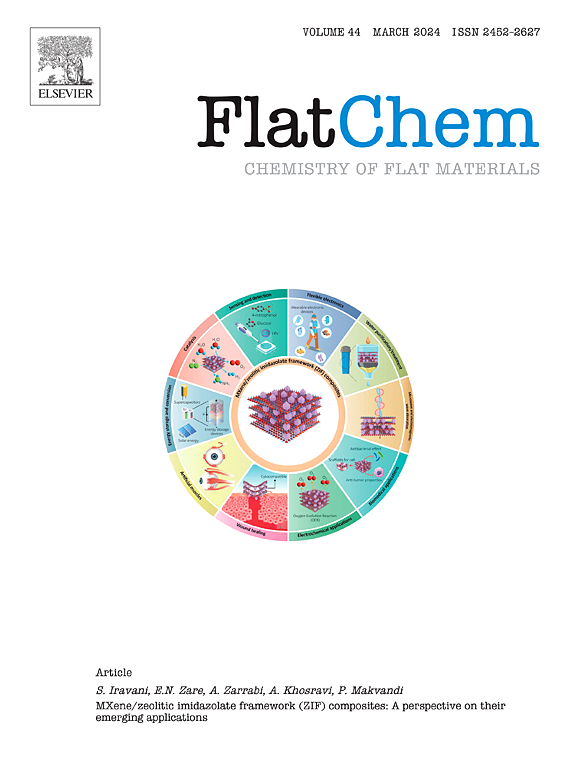A theoretical study on ion irradiation engineered defect formation and hydrogen evolution on two-dimensional MoS2
IF 6.2
3区 材料科学
Q2 CHEMISTRY, PHYSICAL
引用次数: 0
Abstract
Via density functional theory, ab initio molecular dynamics and Monte Carlo simulations, we demonstrate the feasibility of ion irradiation for engineering defect formation and electrocatalytic activity of hydrogen evolution reaction (HER) on 2D MoS2. Systematic ion irradiation simulations with different incident ions (C, O, Ne, and Ar), incident energies and ion fluences allow the identification of irradiation conditions for achieving a sulfur vacancy (VS) of ∼9 %, an optimal defect concentration for HER activity. With the desired concentration, we reveal that lower incident energy or heavier ions require smaller ion fluence, attributed to the larger cross section for defect generation. Analyses on electronic properties reveal a metallic behavior of the irradiated structures, suggesting improved electrical conductivity. We further calculate the Gibbs free energies of H adsorption (ΔGH), and find that the ΔGH for irradiated structures are significantly reduced (∼ − 0.1 eV) as compared to the value for pristine MoS2 (∼2.0 eV). Our findings not only provide a practical approach for rational design and optimization of MoS2 electrocatalysts for efficient hydrogen production, but also pave an avenue for property modification of 2D nanodevices by ion beam irradiation.

离子辐照工程二维二硫化钼缺陷形成和析氢的理论研究
通过密度泛函理论、从头算分子动力学和蒙特卡罗模拟,我们证明了离子辐照在二维二硫化钼上形成工程缺陷和析氢反应(HER)电催化活性的可行性。采用不同入射离子(C、O、Ne和Ar)、入射能量和离子影响进行系统离子辐照模拟,确定了实现硫空位(VS)为~ 9%的辐照条件,这是HER活性的最佳缺陷浓度。在期望的浓度下,我们发现较低的入射能量或较重的离子需要较小的离子影响,这归因于较大的缺陷生成截面。电子特性分析揭示了辐照结构的金属行为,表明电导率有所提高。我们进一步计算了H吸附的吉布斯自由能(ΔGH),发现与原始MoS2 (~ 2.0 eV)相比,辐照结构的ΔGH显著降低(~−0.1 eV)。我们的研究结果不仅为合理设计和优化MoS2高效制氢电催化剂提供了可行的方法,而且为离子束辐照修饰二维纳米器件的性能铺平了道路。
本文章由计算机程序翻译,如有差异,请以英文原文为准。
求助全文
约1分钟内获得全文
求助全文
来源期刊

FlatChem
Multiple-
CiteScore
8.40
自引率
6.50%
发文量
104
审稿时长
26 days
期刊介绍:
FlatChem - Chemistry of Flat Materials, a new voice in the community, publishes original and significant, cutting-edge research related to the chemistry of graphene and related 2D & layered materials. The overall aim of the journal is to combine the chemistry and applications of these materials, where the submission of communications, full papers, and concepts should contain chemistry in a materials context, which can be both experimental and/or theoretical. In addition to original research articles, FlatChem also offers reviews, minireviews, highlights and perspectives on the future of this research area with the scientific leaders in fields related to Flat Materials. Topics of interest include, but are not limited to, the following: -Design, synthesis, applications and investigation of graphene, graphene related materials and other 2D & layered materials (for example Silicene, Germanene, Phosphorene, MXenes, Boron nitride, Transition metal dichalcogenides) -Characterization of these materials using all forms of spectroscopy and microscopy techniques -Chemical modification or functionalization and dispersion of these materials, as well as interactions with other materials -Exploring the surface chemistry of these materials for applications in: Sensors or detectors in electrochemical/Lab on a Chip devices, Composite materials, Membranes, Environment technology, Catalysis for energy storage and conversion (for example fuel cells, supercapacitors, batteries, hydrogen storage), Biomedical technology (drug delivery, biosensing, bioimaging)
 求助内容:
求助内容: 应助结果提醒方式:
应助结果提醒方式:


